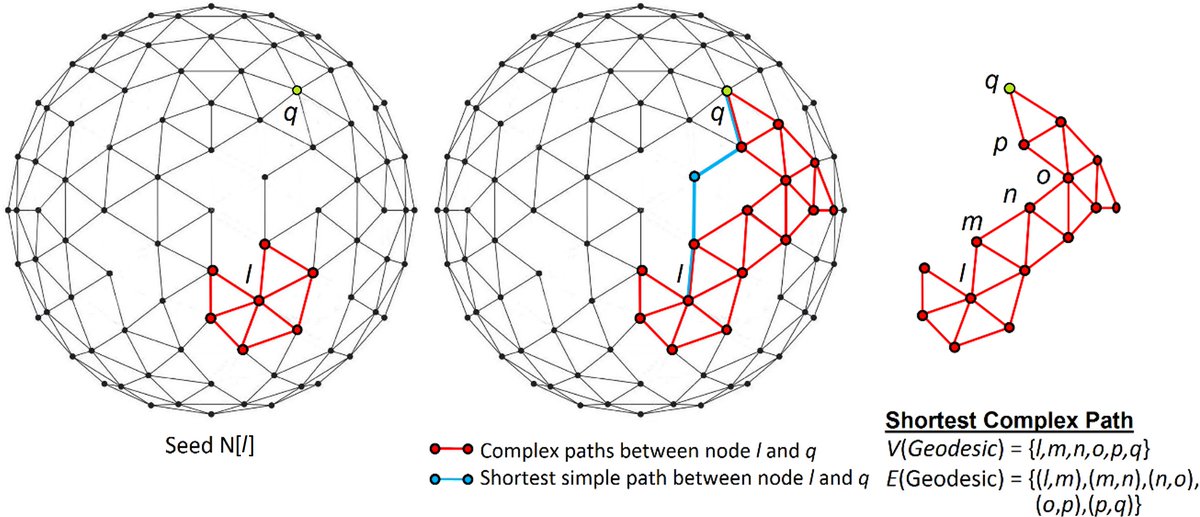
What is the best way to spread beliefs, behaviors, and technologies? @DamonCentola and I provide novel insights into this problem in “Topological Measures for Identifying and Predicting the Spread of Complex Contagions” out today in @NatureComms nature.com/articles/s4146… 🧵
2/ Marketing often targets influencers who have many connections and who broker communities. But if the behavior is a complex contagion that requires influence from multiple peers (eg diet), then the connections of influencers may not be connected enough to trigger spread. 

3/ We show that the people who are capable of spreading complex contagions to the largest number of people have surprisingly few connections and do not broker communities, but are rather deeply embedded within them. We provide formal methods for identifying these network hotspots
4/ To identify influencers for complex contagions, we revise definitions of path length and centrality for social networks, which classically assume that contagions are simple (ie that exposure to one person is enough to adopt the contagion). 

5/ Paths for complex contagions are chains of reinforced ties, where each step consists of a “wide bridge” sufficient for spreading. The fraction of sufficient bridges in a social network provides a strong predictor of whether a complex contagion will cascade globally. 

6/ We also use our definition of complex path length to define complex centrality for each node, which refers to the average length of the complex paths emanating from a given node. Influencers for complex contagions participate in the longest and most robust complex paths.
7/ We show that seeding with complex centrality leads to significantly greater levels of contagion adoption than when seeding with extant centrality measures based on classical path length, including degree, betweenness, eigenvector, k-core, and percolation centrality.
8/ We demonstrate this by simulating diffusion in empirical adolescent friend networks from over 70 U.S. communities (the Add Health dataset). We find that adolescents with the highest complex centrality have comparatively low influence according to extant measures of centrality 

9/ Huge shout out to @KirellBenzi for producing this stunning visualization of all the add health networks used in our analysis – a moving example of how data art can inspire scientific inquiry. Follow more of his work here: kirellbenzi.com 

10/ We conclude by showing that complex centrality is better at identifying influencers in the empirical spread of a microfinance program in over 40 rural Indian villages (using the Banerjee et al. 2013 dataset: science.sciencemag.org/content/341/61…)
11/ These results are robust to a wide range of controls: network structure, influence model (Independent Cascade and Linear Threshold), adoption threshold type/distribution, and seeding budget. We thank our reviewers across venues for pushing us to extend and test our theory!
12/ What I find most exciting: these results challenge our folk theories of influence. We can intuitively identify brokers and people with many connections. But how can you tell a complex influencer? It’s structural – a function of their embeddedness in the social structure.
13/ Moreover, complex influencers dwell in the periphery of a network, with few connections – ie the folks we traditionally think are not influential! These are the actors capable of initiating the most social change via complex contagions.
14/ Easy to use R scripts for reproducing our results and for measuring complex path length/centrality are available at the git: github.com/drguilbe/compl…. A full code base will soon be released, potentially as package in Python or R.
15/Possible extensions– let’s team up! Does complex contagion arise in belief networks human & ML? Which ideas exhibit complex centrality? Can new complex contagions in culture be anticipated? How would it impact people if they learned they are more influential than they realize?
16/ People exhibit complex centrality unknowingly. I am reminded of Wordsworth’s line in Tintern Abbey -- “that best portion of a good person’s life, those little, nameless, unremembered, acts of kindness.” How many of these ripple out? Can computational sociology reveal this?
17/ No doubt there are ways to improve and deepen the mathematical formalisms we provide. Please reach out if you are interested in exploring next steps! My intuition is that hypergraphs and hyperedges may be really useful for modeling complex paths.
18/ Stay tuned for ongoing work using complex paths/centrality to understand how new categories emerge and are synthesized in social networks, across cultural contexts: nature.com/articles/s4146…
19/ And thanks to all who read through, and for your interest in our work!
• • •
Missing some Tweet in this thread? You can try to
force a refresh



